Your gait refers to your manner or pattern of walking, and gait training refers to the process of improving your walking function and mechanics through practice and specific exercise.
Some people require gait training after a physical injury like breaking a bone. But this article will focus specifically on gait rehabilitation after a neurological injury such as a stroke.
Gait training for stroke patients takes a slightly different approach, which this article will cover. We will also provide some exercises and rehab methods to help you get back on your feet.
Gait Training: Improving Your Ability to Walk
When someone has a stroke, their ability to walk may be impaired. This can be because the brain has difficulty sending the correct signals your body, resulting in weakness, imbalance, or coordination issues that affect gait.
Depending on the type of stroke and what part of the brain is affected, patients may struggle with different aspects required for proper gait. Some examples include, but are not limited to:
- Decreased dorsiflexion (the ability to lift the front part of your foot upwards), knee flexion (bending), and hip flexion (lifting the thigh) that make it harder to swing your leg through each step.
- Hip and/or quadriceps weakness, resulting in decreased knee stability.
- Joint stiffness or muscle tightness/spasticity limiting your range of motion.
To help with these problems or any others that affect your walking, your physical therapist will guide you through various gait training exercises specific to your needs. The goal of these exercises is to help spark neuroplasticity to rewire the brain. This will in turn help re-establish communication back to your body and legs.
Some other goals of gait training include:
- Increasing muscle strength and mobility in the legs
- Improving balance and coordination
- Increasing cardiovascular fitness
The best way to get there is with gait training exercises.
Gait Training Exercises for Stroke Patients to Try at Home
Effective gait training exercises primarily target the legs, of course, but that’s not all. Walking is a full-body task that requires coordination from your feet, trunk and even your arms.
The following gait training exercises target all of these muscles groups to help improve your balance and coordination while walking. The photos feature therapists Liliana, DPT, and Cassie, DPT.
Here are some excellent gait training exercises that can help improve your ability to walk:
1. Seated Marching
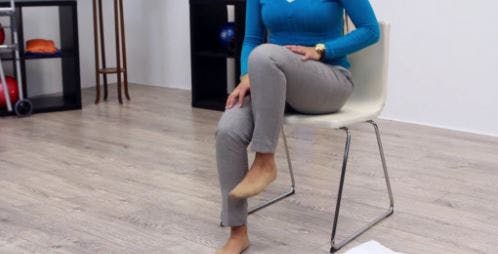
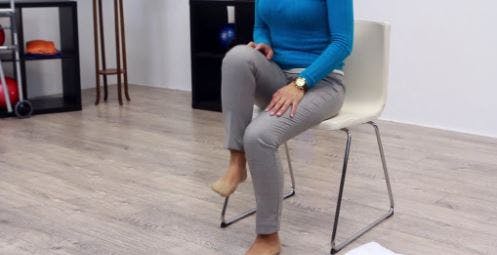
This basic gait training exercise can be done from any seated position. Start by lifting your affected leg up into your chest, and then place it back down onto the floor. Then repeat on the other leg, alternating back and forth. Do a total of 20 to 30 repetitions.
Be mindful of keeping your back straight and maintaining controlled movement. To add some challenge, pause at the top for a second or two. You can even add arm swings (opposite arm, opposite leg) like you’re walking in place on the chair.
2. Knee Extension
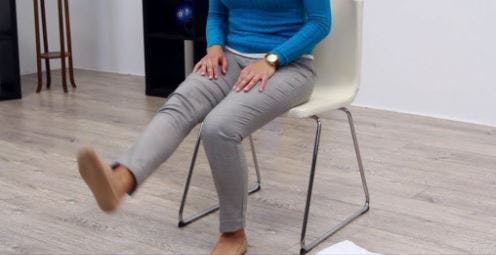
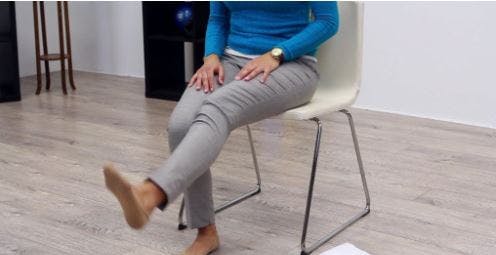
Knee extensions are an important gait training exercise because it helps to strengthen our quadriceps muscles and improve our leg mobility.
To perform this exercise, start from a seated position. Extend your leg out in front of you parallel to the floor, making sure to contract your thigh muscles at the top. Then, slowly bring your foot back down to the floor. Alternate back and forth between your right and left leg while maintaining your posture (this takes core stability). Repeat for 10 repetitions.
Watch Liliana, DPT, demonstrate more leg exercises for stroke patients in this video:
Now let’s move onto some balance and core exercises that can help improve your gait.
3. Toe Taps
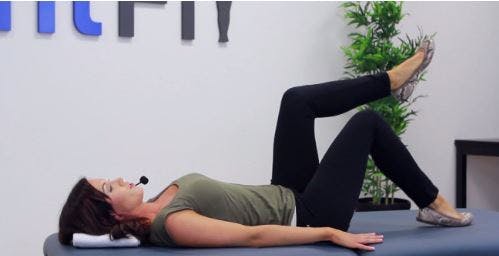
Building a strong core is essential for improving your gait. This exercise targets all the muscles in your core.
Lay on your back with both legs bent up at a 90 degree angle. Try flattening your lower back against the ground by engaging your abdominals. Make sure you’re still able to breathe! Your shins should be parallel to the floor and your core should be fully engaged.
From there, slowly lower to tap your left foot on the floor and bring it back up to the starting position. Repeat on the other leg and alternate between each leg for a total of 20 repetitions, focusing on keeping your spine flat and neutral on the ground throughout the exercise.
4. Knee to Chest
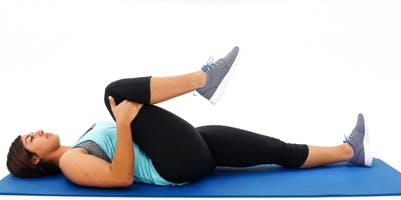
For this gait training exercise, start from a comfortable lying position. Pull one knee up and hug it into your chest while the other leg stays straight resting on the floor. Hold for 3 to 5 seconds, then alternate legs for a total of 10 repetitions.
Try not to use your leg muscles to achieve this movement. Focus specifically on engaging and tightening your core.
5. Flamingo Stands
For this simple gait training exercise, stand like a flamingo. Meaning, practice standing on one leg for about 30 seconds and then switch to the other foot.
A little bit of shaking is normal! The best way to improve your balance is by challenging it, but make sure you are in a safe area with a chair, bed, or wall directly behind you in case you lose your balance. Hold onto a chair, counter top, or table for safety and stability.
When you’re ready for a challenge, progress yourself from using two hand support to one hand, then to fingertips until eventually you can hold your balance without holding onto anything.
6. Side Leg Raises
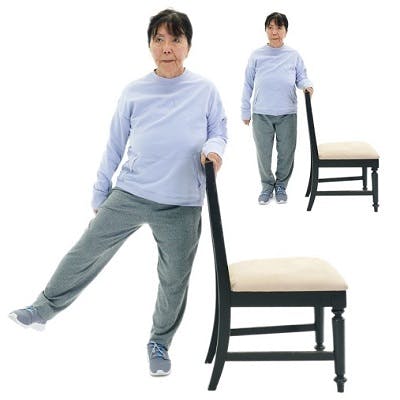
For this gait training exercise, start in a standing position. Then, lift your leg out to your side about 45 degrees (or as far as you can). Hold it there for a few seconds and then bring your foot back down. The key is keep your core stable and not lean your trunk. The only thing that should be moving is your leg. Do 15 repetitions, then switch sides.
Watch Cassie, DPT, demonstrate more core exercises for stroke patients in this video:
Now let’s move onto some foot exercises that can help improve your gait and stability while you walk.
7. Ankle Dorsiflexion
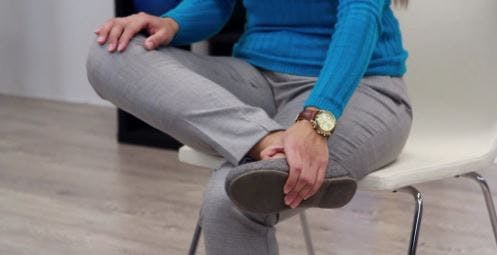
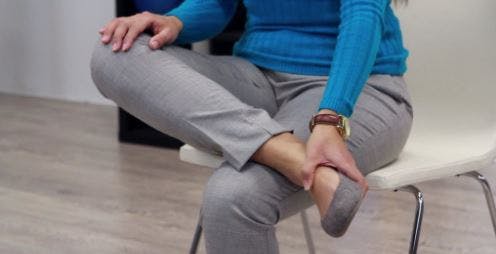
This gait training exercise will help target your feet and improve conditions like foot drop after stroke. To begin, start from a seated position and cross your affected leg over you other leg. Then, move your foot into dorsiflexion (image 1) by using your unaffected hand to move your foot up towards your knee. Next, move into plantar flexion (image 2) by extending your foot back down.
For added challenge, complete these exercise without the use of your hand. (That would turn this into an active exercise instead of a passive exercise.) Aim for a total of 20 repetitions
8. Assisted Toe Raises
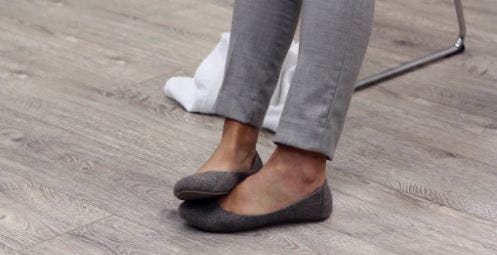
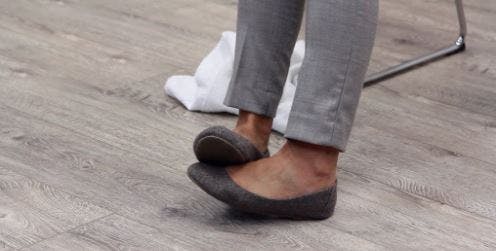
This gait training exercise can be difficult if you have foot drop. However, it can help improve foot drop by retraining the brain to send the correct signals to your foot.
Start from a seated position. Then place your unaffected foot underneath your affected foot. Then, use your foot to assist your affected foot up. Then release back down. Once you regain the ability to perform these without assistance, do active exercise for added challenge. Perform a total of 15 repetitions.
9. Heel Raises
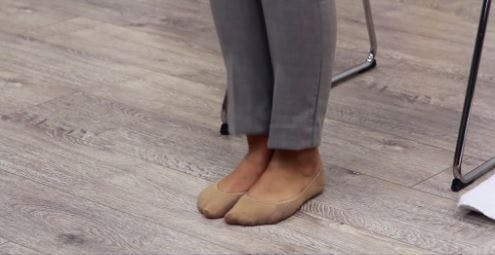
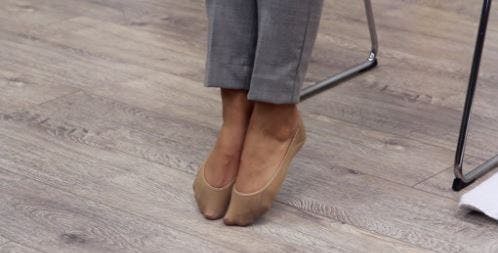
This is an advanced gait training exercise. Start seated with your feet flat on the ground. Then, point your toes and lift your heels off the ground. Then place your feet back down flat on the floor and repeat. You should feel this in your calf muscles.
Increase the challenge by doing this same exercise in standing. Do 15 repetitions, making sure to keep your weight equal through both feet.
While this concludes our list of gait training exercises, your recovery doesn’t have to stop here! There are plenty of other ways to boost your results and get back on your feet faster.
Other Methods of Gait Rehabilitation
Gait training exercises are just one way to improve your gait and walking abilities after a stroke.
Here are other excellent gait rehabilitation methods:
Strength Training
Some muscle atrophy is common after a stroke. Therefore, adding some strength training can help improve your lean muscle mass and strength, which is necessary for gait. Without the appropriate strength, your muscles may have difficulty performing necessary actions while walking like your quadriceps stabilizing your knee or your calf muscles to push off each stride.
Balance and Core Training
Balance and core training both help improve gait. Walking is a full-body task that requires coordinated movement from the feet, legs, and core. With balance and core training, you can improve your stability while walking and reduce your falls risk. This is especially important when walking on uneven surfaces you might encounter in the park, crosswalks, and dirt trails.
Functional Electrical Stimulation
Adding electrical stimulation to the affected muscles during gait training exercises can help boost results, according to studies. Be sure to work with a physical therapist to learn where to place the electrode pads and the appropriate device settings as it will differ for everyone.
High-Tech Home Exercise Equipment
Improving your ability to walk requires a high repetition of gait training exercises. More repetition helps stimulate the brain and boosts neuroplasticity. High-tech exercise equipment like Flint Rehab’s FitMi can help. Many patients have gotten back to walking and driving (i.e. targeting the gas pedal) by using FitMi consistently.
Walking Itself
Another way of increasing neuroplasticity is working on movements and activities that are specific to your goals. So one of the best methods to improve your walking is by directly practicing walking. Many rehabilitation facilities have bodyweight support systems that you can use for gait training on a treadmill.
However, on your own, you can start with a short distance, like 1 block, and gradually increase how far you walk each week. Even if you have weakness or spasticity, focus on making your gait as smooth, symmetrical, and natural as you possibly can. Every step is a rep, and repetition matters!
By combining the gait training exercises covered in this article with some of the other methods described above, you will be able to take a comprehensive approach to improving your gait. As always, be sure to consult with your physical or occupation therapist first before making changes to your rehabilitation program.
Getting Started with Walking Exercises for Stroke Patients
Gait training exercises can improve your strength, mobility, balance, and coordination, which can all help prevent falling after stroke. Ultimately, a consistent rehab exercise program can help you get you back onto your feet and back to the activities that you enjoy.
Focus on high repetition of exercises to help rewire the brain. Be sure to target your core along with your legs to improve overall coordination and balance. You can add booster techniques, like electrical stimulation and FitMi home therapy, for even faster results. By using these methods, you can improve your walking ability and reclaim your independence after stroke.
The post Gait Training Exercises for Stroke Patients: How to Improve Your Walk appeared first on Flint Rehab.



